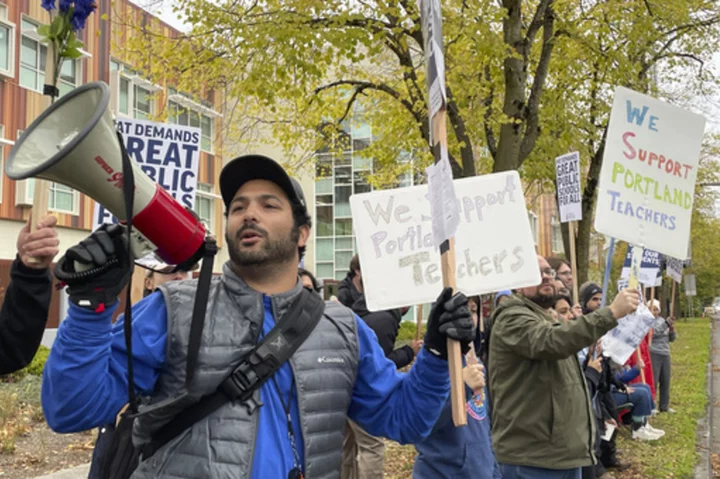PORTLAND, Ore. (AP) — Teachers in Portland, Oregon, walked off the job on Wednesday for the first day of a strike that shuttered schools for some 45,000 students in Oregon's largest city.
Concerns over large class sizes, salaries that haven't kept up with inflation and a lack of resources prompted the strike, one of the latest signs of a growing organized labor movement in the U.S. that's seen thousands of workers in various sectors take to the picket lines this year.
“Our kids deserve more than teachers that are absolutely exhausted and at the end of their ropes,” said Sarah Trapido, a special education teacher at Kellogg Middle School who was picketing Wednesday morning.
The Portland Association of Teachers, which represents more than 4,000 educators, said it was the first-ever teachers strike in the school district. The union has been bargaining with the district for months for a new contract after its previous one expired in June.
Portland Public Schools said it doesn't have the money to meet the union's demands. Oregon lawmakers in June approved a record $10.2 billion K-12 budget for the next two years, but school district representatives said that wasn’t enough.
“Funding has not kept pace with the needs of our students, nor our educators,” Superintendent Guadalupe Guerrero told reporters on Wednesday. “We strive to offer a compensation that attracts and retains talent. But unlike a private organization, we don’t have record profits we can tap into.”
Schools are closed and there is no classroom or online instruction during the strike. Guerrero said the district is scheduled to meet with the union and a state mediator on Friday.
Teachers held signs, chanted and rallied the crowd with bullhorns outside of Kellogg Middle School on Wednesday morning as cars passing by honked in support. Educators said they feel overwhelmed by their workload and what they described as a lack of support in the classroom.
Trapido said she regularly works through her lunch break and continues once she gets home until 8 or 9 p.m. She often relies on a volunteer to help with her students.
“She walks in and I’m just like, ‘Thank goodness,’” Trapido said. With the volunteer’s help, she said, she can help a kid go to the bathroom, get herself a drink of water — which she might not have had all day — or help a group that she hasn’t had a chance to work with.
Katarina Juarez, an eighth grade language arts teacher at Kellogg Middle, said she often stays at school until 7 p.m. to get her work done. Doctors have suggested that she quit because of the toll her job has taken on her physical health, she said.
“I feel like I’m failing them if I’m not putting that time in,” she said. “But I’m really harming myself and my family in the process.”
Mike Bauer, a union representative and special education teacher at Cleveland High School, said teachers were stressed about the strike but felt it was the right way to advocate for their students. He said that smaller class sizes would both lighten educators’ workload and help them give students more individualized attention if they’re struggling.
Questions of pay — particularly for teachers just starting their career — have also been raised as the cost of living has increased in Portland, he said. The annual base salary in the district starts at roughly $50,000.
“I've seen many people quit within their first five years,” said Bauer, who's been teaching in Portland for nearly two decades. “At the end of the day, we need teachers.”
The union has proposed a roughly 20% salary increase over three years. The district, meanwhile, has proposed around half that.
The union's demands also include more daily and weekly planning time for teachers to prepare lessons, particularly for those in elementary school, and capping class sizes at certain thresholds that are lower than what the district has proposed in some instances.
The district said the union’s proposals would create hundreds of millions of dollars in additional spending and result in potential staffing cuts. It also cited declining enrollment as a financial concern — the district has lost nearly 3,000 students since the COVID-19 pandemic hit in the 2019-20 school year, state data shows.
Nearly two weeks ago, the union announced that 99% of teachers voted in favor of the labor action, with 93% of its members participating in the ballot.
After the union voted to authorize the strike, the district said it wanted to reach a fair settlement.
Oregon Gov. Tina Kotek had urged the union and the school district to come to an agreement and avoid a walkout.
Oregon's U.S. Senators have also weighed in.
“They have been underpaid and overstressed, and we strongly affirm our support for Portland’s educators exercising their right to strike for an equitable collective bargaining agreement,” U.S. Sens. Jeff Merkley and Ron Wyden said in a joint statement Wednesday. “At the same time, we urge leadership from both the Portland Association of Teachers and Portland Public Schools to continue working in good faith toward an agreement."
Public education has been gripped by a series of high-profile strikes this year.
In the Los Angeles Unified School District, the nation’s second-largest, workers including teachers’ aides, cafeteria workers and custodians walked out for three days in March to demand better wages and increased staffing, shutting down education for half a million students.
In Oakland, California, the union representing teachers, counselors, librarians and other workers went on strike for more than a week in May. In addition to typical demands such as higher salaries, it also pushed for “common good” changes, such as reparations for Black students and resources for students who are homeless.
___
Claire Rush is a corps member for the Associated Press/Report for America Statehouse News Initiative. Report for America is a nonprofit national service program that places journalists in local newsrooms to report on undercovered issues.

